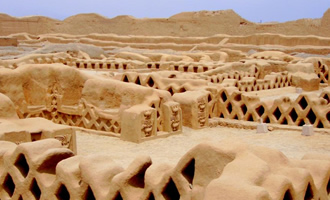Trujillo & Chiclayo

Local People

Chan Chan

Huaca del Sol
In Trujillo, spring is eternal. The sun always shines, filling even the most secluded corners of the capital of the department of La Libertad with light. This light brightens the spirit of an affable and cordial people, who live proud of their adobe citadels built by the Chimus and Mochicas; their stately mansions, heritage of colonial times and the beginnings of the Republic; and of the ‘marinera’, the national dance of Peru, a whirl of sensuality and gallantry from which love is born.
Trujillo, in the northern coast of Peru, was founded in 1534 by Don Diego de Almagro, who, on stopping in the valley of the Moche river on his advance toward Pachacamac (Lima), “found the place promising and suitable for founding a city”, and named it after the Spanish city where conquistador Francisco Pizarro was born. From the day of its foundation, the city progressed rapidly owing to the productivity of the valley and the tenacity of its people; builders of stately mansions with outstanding artistic window railings in wrought iron, adding a touch of distinction and elegance to Trujillo’s architecture.
The city of Chan-Chan is also in the Moche valley, capital of the Kingdom of the Great Chimu, considered the largest city in the world to be built out of mud (adobe) and covering an area over 20 square kilometers square.
The Huaca del Sol , a stepped pyramid 20 meters high; the Huaca de la Luna, with murals representing the rituals of the Mochicas, and the Complejo del Brujo (El Brujo complex), distinguished for an adobe pyramid 30 meters high and over 15 centuries old, are evidence of the greatness of the first peoples to inhabit the north coast of Peru.
Chiclayo was founded in 1560 as a rural Indian village by a Spanish priest. Until the 19th century, Chiclayo remained a small town in comparison to the nearby city of Lambayeque. Since then, however, the city of Chiclayo has grown into a major modern metropolis.
The Lambayeque region of Peru, in which Chiclayo lies on the coast, gave rise to the great Mochica culture from 0-600 AD. Legend has it that the god Naylamp sailed here together with a vast retinue thousands of years ago to found his empire.
Chiclayo and other towns in northern Peru are centres of witchcraft and well known for their archaeological sites, such as Túcume, Batán Grande and Huaca Rajada. In 1987, in Huaca Rajada (more often referred to as Sipán), an exceptional Moche mausoleum was found.
The Lord of Sipan, the most significant archeological discovery in the region was the tomb of the Señor de Sipán, discovered close to the coast, in the middle of Lambayeque Valley, just 35 kms. east of Chiclayo. The Señor de Sipán, or “Lord of Sipan” wore funeral clothes adorned with gold, silver and jewels.
*ACTIVITIES.
Travel Connections provides breakfast and dinner and all transfers during their tours.

